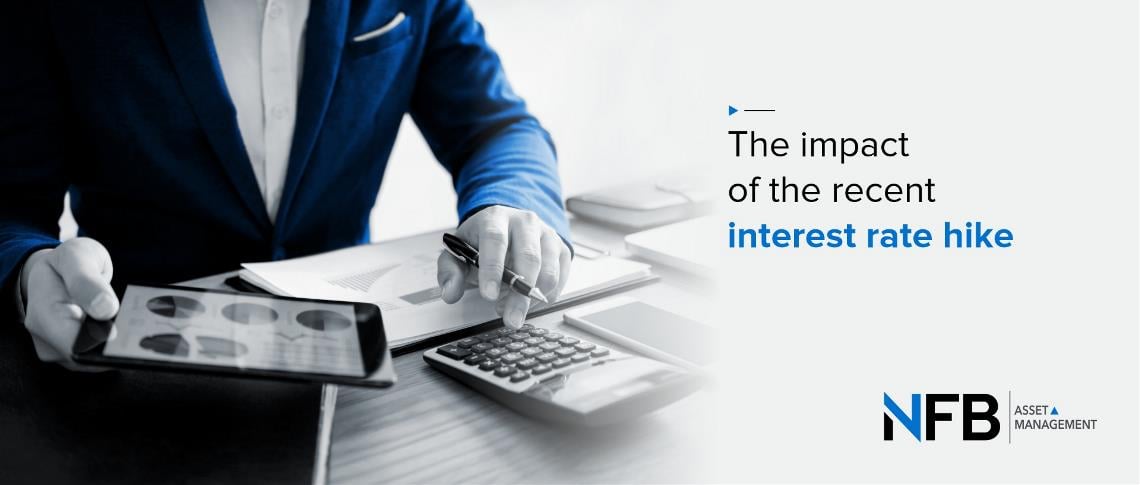The impact of the recent interest rate hike
The rate increase indicates the start of a normalisation of monetary policy but what does this mean for the man on the street.


As expected, the South African Reserve Bank’s monetary policy committee (MPC) raised the repo rate by another 25 basis points in late January.
This follows a similar 25 basis points hike in November 2021 which was the first time in three years that rates had been raised and which appeared to be in response to the Bank’s concern around the upside risk of inflation. After the first hike last year, Reserve Bank governor Lesetja Kganyago said the bank’s monetary policy stance remained accommodative. Real interest rates, in other words interest rates after subtracting inflation, remained at very low levels.
This latest hike sees the interest rate grow to 4% while the prime lending rate increases to 7.5% and is part of a normalisation of monetary policy.
The consensus amongst economists is that rates will see a total hike of more than 100 basis points by the end of 2022 and an additional 100 basis points in 2022. This is the first of the increases which had been widely anticipated. In total, markets are pricing in seven to eight additional increases: three to four more for 2022 and one for each quarter of 2023; with an increasing probability that one or more of these increases will be more than the standard hike of 25 basis points.
The big question is whether inflation – which needs to be accelerating – and economic growth – which needs to be rising – justify these increases? Although inflation rates will probably justify these hikes, growth rates are unlikely to do the same.
The yields on nominal bonds and inflation-linked bonds are a good indicator of what the market expects inflation to do in the coming months. All indications are that the market expects inflation in the region of 5.5% to 6.5% which is manageable. Inflation is only a concern if it starts to breach 7% or 8%. The expectation is that the majority of the inflation in the medium term will be driven by supply-side constraints including the high cost of electricity and fuel, potentially joined by food price inflation.
What is becoming increasingly apparent is that the local economy has become mired in a low-growth quagmire. Far from inflation being a problem, the economy is unable to generate demand-pull inflation.
The IMF recently cut South Africa’s growth prospects for 2022 from 2.2% to 1.9% citing subdued investor sentiment and lower growth than anticipated in the second half of 2021, and even slow growth of 1.4% in 2023.
The IMF’s forecast mirrors that of the Reserve Bank which anticipates growth of 1.7% this year and 1.8% next year.
The Reserve Bank’s decision to start hiking local interest rates followed a decision by the US Federal Reserve in 2021 to begin withdrawing its bond purchase programme by US$15 billion a month. The latter has indicated that its first interest rate hike is likely to occur in March this year and that rate increase are likely to occur quicker than previously anticipated.
Other countries have followed suit, including Canada, which ended its bond purchases earlier than expected. In December the Bank of England raised interest rates by 0.15 percentage points to 0.25%.
The European Central Bank, while leaving key interest rates unchanged, has lowered the pace of its bond purchases.
All indications are that the Reserve Bank’s MPC is also concerned with interest rates globally. Local interest rates will come under pressure if US interest rates rise faster than expected, or by more than expected.
The turning interest rate cycle will be a small benefit for money market investors who will see marginally higher returns.
Should interest rates continue to rise as they are expected to do, indebted and unemployed consumers will be placed under even more financial pressure, particularly when combined with increased utility and fuel prices. According to Statistics South Africa, the country’s unemployment rate hit a new high of 34.9% in the third quarter of 2021.
The unemployment figures are even more concerning under the expanded definition which includes discouraged jobseekers. Under this definition, unemployment has risen to an alarming 46.6%. The youth unemployment rate is currently 66.5%. The fact that close to half the economically active population is jobless is a worrying indicator of the health of the economy. Rising interest rates certainly don’t auger well for this sector of the population.
Predictions, however, are just that. It is only with hindsight that we will really understand whether the current inflation is structural or transitory and will recede in time.













